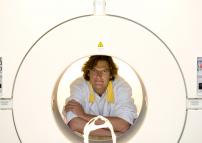prof. Steven Laureys
Steven Laureys MD PhD, is director of the Coma Science Group (http://www.comascience.org) at the Cyclotron Research Centre and Neurology Department of the University and University Hospital of Liège, Belgium. He is Research Director at the Belgian National Fund for Scientific Research and board-certified in neurology and in palliative medicine. His team assesses the recovery of neurological disability and neuronal plasticity in acquired brain injury and altered states of consciousness (e.g., comatose, “vegetative”/unresponsive, minimally conscious and locked-in syndromes) confronting clinical expertise and bedside behavioral evaluation with multimodal neuroimaging (PET and MRI) and electrophysiology studies (EEG and EEG-TMS); also dealing with the ethical implications of this translational clinical research.
He is chair of the World Federation of Neurology Applied Research Group on Coma; chair of the European Academy of Neurology Subcommittee on disorders of consciousness and is in the Board of Governors of the International Brain Injury Association. He is recipient of the Cognitive Neuroscience Society Young Investigator Award, the William James Prize (Association for the Scientific Study of Consciousness) and the Blaise Pascal Medal of Medicine of the European Academy of Sciences. Laureys has edited 5 books and over 250 scientific papers indexed on Pubmed (H-index 75).
- Diagnostic precision of PET imaging and functional MRI in disorders of consciousness: a clinical validation study Lancet (2014) Apr 15
- Consciousness and complexity: from theory to practice Science Translational Medicine (2013) Aug 15
- Disorders of consciousness: responding to requests for novel diagnostic and therapeutic interventions Lancet Neurology (2012) 11:732-738
- Bedside detection of awareness in the vegetative state Lancet (2011) (9809) 2088-94
- Preserved feedforward but impaired top-down processes in the vegetative state Science (2011) 858-862
- Willful modulation of brain activity in disorders of consciousness New England Journal of Medicine (2010) 579-89
The Coma Science Group aims to improve the medical care and scientific understanding of coma and disorders of consciousness. His multidisciplinary team, in collaboration with international expert centers, assesses the residual cognitive function and recovery of neurological disability and neuronal plasticity in severely brain damaged patients by means of clinicometric and multimodal neuroimaging and electrophysiological measurements. It aims at characterizing the evolution and changes in brain structure and function in comatose, vegetative/unresponsive, minimally conscious and locked in states. The importance of his project is threefold: 1) patients in coma and related states continue to represent a major clinical problem in terms of diagnosis, prognosis, and treatment; 2) the exploration of brain function in disorders of consciousness represents a unique lesional approach to the identification of the 'neural correlate of consciousness'; 3) new scientific insights have major ethical, societal & medico-legal implications.
In a collaborative effort between the CRCyclotron and the CHU University Hospital we confront clinical expertise and standardized behavioral evaluation with state-of-the-art imaging combining information from fluorodeoxyglucose positron emission tomography, magnetic resonance imaging (encompassing “resting state”, functional activation, structural, diffusion tensor, spectroscopy and arterial spin labeled perfusion acquisitions) and electrophysiological recordings (event related potential and high-density electroencephalography coupled to transcranial magnetic stimulation).
Our main research objectives can be summarized as follows: Objective 1) Understanding the natural history of coma and disorders of consciousness; 2) Improving the diagnostic accuracy; 3) Predicting outcome and disability; 4) Understanding neuronal plasticity and improving recovery; 5) Searching for the neural correlates of consciousness; 6) Studying the ethical and social implications.



